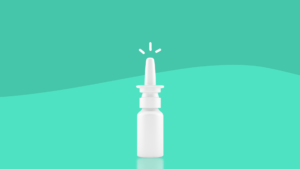Are you tired of feeling like your obsessive-compulsive disorder (OCD) is controlling your life? Have traditional treatments failed to provide the relief you need? Look no further than esketamine, a new and innovative treatment option that’s taking the world by storm. In this blog post, we’ll dive into everything you need to know about esketamine for OCD, from its benefits and potential side effects to how it works and who can benefit from it.
Contents
- 1 What Is OCD?
- 2 What Is Esketamine?
- 3 How Does It Work?
- 4 Who Is a Good Candidate for Esketamine Treatment?
- 5 How to Prepare for Esketamine Treatment?
- 6 What to Expect During and After Treatment?
- 7 Pros of Esketamine
- 8 Risks and Side Effects of Esketamine
- 9 Alternatives to Esketamine Treatment
- 10 Conclusion
What Is OCD?
Obsessive-compulsive disorder (OCD) is an anxiety disorder in which people have unwanted and repeated thoughts, feelings, images, or sensations (obsessions) that make them feel driven to do something (compulsions). Many people with OCD have both obsessions and compulsions.
OCD can cause a great deal of distress. It can take up a lot of time and get in the way of important activities such as work, school, or relationships. People with OCD may try to hide their symptoms because they feel ashamed or embarrassed.
Symptoms usually begin in childhood, adolescence, or early adulthood. They tend to peak in the early 20s and then decline over time. It also tends to run in families, although the exact cause is unknown.
What Is Esketamine?
Esketamine is a drug that’s been approved by the US Food and Drug Administration (FDA) for the treatment of OCD. It belongs to a class of drugs known as NMDA receptor antagonists, which work by blocking certain neurotransmitters in the brain that are involved in obsessive-compulsive behavior.
Esketamine is also used to treat OCD, depression, and post-traumatic stress disorder (PTSD).
How Does It Work?

The working of Esketamine on OCD is complex and not fully understood yet. Studies have suggested that esketamine helps to reduce symptoms of OCD by increasing the level of another neurotransmitter called gamma-Aminobutyric acid (GABA). GABA is an inhibitory neurotransmitter that helps to control the activity of glutamate. By increasing GABA levels, esketamine helps to reduce the activity of glutamate and therefore, reduces the symptoms of OCD.
Accumulating evidence shows that esketamine may be effective in reducing the severity of OCD symptoms. For instance, a study in 2016 showed that esketamine was effective in treating severe OCD and helped to reduce symptom severity by up to 50% after 8 weeks of continued use.
Esketamine is currently being used off-label as an augmentation therapy alongside other medications such as SSRIs, SNRIs, and tricyclic antidepressants. It is usually used when other medications are not providing enough relief or when the patient’s OCD is resistant to treatment with traditional therapies.
Who Is a Good Candidate for Esketamine Treatment?
Many people may benefit from esketamine treatment for OCD. Some good candidates for this type of treatment include those who:
- Have not responded well to other treatments, such as cognitive behavioral therapy or medication.
- Have severe OCD that significantly interferes with daily life.
- Are at risk for suicide or self-harm.
- Have been diagnosed with both OCD and depression.
- Are willing and able to adhere to the treatment plan.
How to Prepare for Esketamine Treatment?
If you think you may benefit from esketamine treatment, it is important to be prepared before starting your treatments. Here are a few things you can do to prepare for esketamine treatment:
1. Talk to your doctor about your expectations and what you hope to achieve from treatment. You and your doctor must be on the same page about your goals for treatment.
2. Make sure you have a support system in place. Esketamine treatment can be challenging, so it is important to have a supportive network of family and friends who can help you through the process.
3. Be aware of the potential side effects of esketamine treatment. Some common side effects include nausea, vomiting, dizziness, drowsiness, and headaches. Be sure to discuss these with your doctor so that you know what to expect and how to deal with them if they occur.
4. Follow all of your doctor’s instructions regarding esketamine treatments. You must follow the protocol prescribed by your doctor to get the most benefit from treatment and avoid any complications.
What to Expect During and After Treatment?

Esketamine is a medication that is used to treat OCD. It is a form of antidepressant that is taken by mouth, and it works by increasing the levels of serotonin in the brain. Serotonin is a neurotransmitter that helps to regulate mood and anxiety.
Esketamine ocd treatment usually starts with a low dose that is gradually increased over time. The usual dose range is 50-200 mg per day. Treatment with esketamine ocd usually lasts for 12 weeks.
After 12 weeks of treatment, your doctor will likely reduce your dose of esketamine ocd gradually over several weeks. It is important to continue taking your other OCD medications during this time.
Thought the treatment process, it is important to speak with your doctor regularly about how you are feeling. It takes time for esketamine OCD to work, so it is important to be patient and have realistic expectations of the results. It can take up to 6 weeks of treatment before any improvement in symptoms is seen.
Pros of Esketamine
Some of the potential benefits of esketamine for OCD treatment include:
- Fast Acting: Esketamine is absorbed quickly and offers fast relief from obsessive-compulsive disorder symptoms.
- Long-Lasting Relief: Studies have shown that the effects of esketamine can last up to six weeks in some cases, offering long-term relief from OCD symptoms.
- Safe: Esketamine is generally considered safe when taken as prescribed, with a low risk of side effects.
- Effective: Studies have shown that esketamine can be effective in reducing OCD symptoms, offering significant relief to those who suffer from the disorder.
- Complementary Treatment: Esketamine can be used in combination with other therapies and medications, providing a more comprehensive approach to managing OCD symptoms.
Risks and Side Effects of Esketamine
Esketamine, while generally safe, can cause some risks and side effects. These include:
- Dizziness: One of the most common side effects is dizziness. This can be a result of the drug’s sedative effects and may increase the risk of falling or other accidental injuries.
- Psychotomimetic Effects: Esketamine has hallucinogenic properties, which can cause patients to experience visual and auditory hallucinations. It is important to monitor patients closely while they are taking esketamine to ensure that these effects do not persist or worsen.
- Nausea and Vomiting: Nausea and vomiting can be a common side effect of esketamine use, especially when taken in larger doses than recommended. To reduce the risk of this occurring, it is important to take the drug as directed by a doctor and to drink plenty of fluids.
- Changes in Mood: Esketamine can also cause changes in mood, such as mania or depression. Patients should be monitored closely for any signs of these symptoms and seek medical help if they do occur.
- Risk of Abuse: Because esketamine has some hallucinogenic properties, it is abused in some cases. Therefore, it is important to take the drug as prescribed and use caution when using esketamine for extended periods.
Alternatives to Esketamine Treatment

There are many alternatives to esketamine treatment for OCD, including behavioral therapy, cognitive therapy, and medication.
- Behavioral therapy is a type of psychotherapy that helps people change their behavior. It can be used to treat various mental health conditions, including OCD. In behavioral therapy, patients are taught how to identify and change the thoughts and behaviors that contribute to their OCD.
- Cognitive therapy is a type of psychotherapy that helps people change the way they think about things. It can be used to treat various mental health conditions, including OCD. In cognitive therapy, patients are taught how to identify and change the thoughts that contribute to their OCD.
- Support Groups: An important part of treating OCD is finding support. Support groups are a great way to find help and support from people who understand what you’re going through.
- Self-Care: An important part of managing OCD is taking care of yourself. Taking time for self-care activities such as exercise, relaxation, and journaling can help you manage your OCD symptoms. Some research even suggests that these activities can be as helpful as medication in treating OCD.
Conclusion
Overall, esketamine has proven to be a useful treatment option for individuals with OCD who have not responded to traditional treatments. Esketamine can reduce the symptoms of OCD quickly and effectively while providing long-term relief from intrusive thoughts and compulsive behaviors.
Of course, it is important to discuss all available treatment options with your doctor before deciding which route is best for you. With its potential benefits and relatively low side effects, esketamine could offer relief from the daily struggles associated with living with OCD.
For more information and guidance, please contact MantraCare. OCD is a mental health disorder characterized by obsessions and compulsions. If you have any queries regarding Online OCD Counseling experienced therapists at MantraCare can help: Book a trial OCD therapy session


